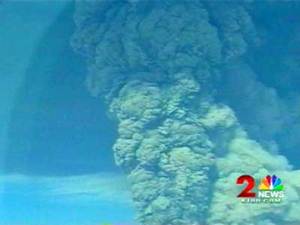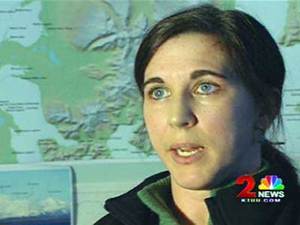
|
| ©KTUU-TV |
| Mt. Spurr eruption of 1992 |
In August 1992, Mt. Spurr sent a plume of ash 40,000 feet into the sky.
The cloud slowly approached Anchorage but eventually surprised many onlookers.
"It was really light, and all of a sudden, the sky just blackened up and we didn't really know what happened," said one onlooker.
But scientists at the newly-formed Alaska Volcano Observatory saw the cloud differently.
Game McJimsey is a Vulcanologist and was working when Mt. Spurr erupted.

|
| ©KTUU-TV |
| Game McJimsey |
"We raced the cloud back to Anchorage, and I was here in the office when the ash fall began, and it was very exciting," McJimsey said. "It was the first time I had ever stood out in the parking lot and had an ash fall, had ash falling on my head. It was kind of neat."
Experience taught volcano observatory staff, and the Federal Aviations Administration to ground all flight into and out of Anchorage, stranding thousands.
As the observatory turns 20 scientists say the size and scope of the operation is really owed to one incident -- and it's not the Spurr eruption.
It was an eruption of Mt. Redoubt three years earlier that, for the first time, taught everyone what happens when airplanes fly near erupting volcanoes.
The hazard and coarse, small ash stops jet engines in their tracks.
In 1989, a KLM 747 with hundreds of passengers was on its way into Anchorage from Amsterdam when the pilots spot trouble.
"It's just cloudy, it's just a little browner than a normal cloud," the pilot said.
At first, everything seemed fine. The plane tried to climb over the cloud but then the first signs of danger became apparent.
Smoke was evident in the cockpit. The plane experienced "flame-out" of all its engines and began descending.
The Anchorage tower briefly lost the plane as it began its 12,000-foot fall -- almost two miles straight down.
The pilots were eventually able to restart two of the engines, but ever since that day, the incident has played a major role in shaping the mission of the Alaska Volcano Observatory.

|
| ©KTUU-TV |
| Kristi Wallace |
Kristi Wallace is a Vulcanologist for the Alaska Volcano Observatory.
"It really hit us hard when we realized that this is a humongous hazard and that we can develop our operations around mitigating that hazard," Wallace said.
That eruption came with little precursory activity, according to scientists with the observatory.
Today, those scientists track Alaska's 100 volcanoes with seismic instruments, aircraft, and satellites.
They don't just learn what happens during an eruption but also determine how to keep remote volcanoes from endangering passing airplanes.
Those remote mountains may not affect lives on the ground but they can potentially disrupt air travel and the hundreds of thousands of people flying to and from Alaska on the edge of the Pacific Rim of Fire.
While large, the 1989 Redoubt and the 1992 Spurr eruptions are not the biggest Alaska has ever seen.
A 1912 eruption of the Katmai Volcano spewed 600 times more magma into the air than more recent volcanoes, according to the volcano observatory.
Observatory staff said it ejected 3 cubic miles of molten rock -- enough to fill the Sullivan arena 232,416 times, making it the largest volcanic eruption in the world within the last 100 years.



Reader Comments
to our Newsletter